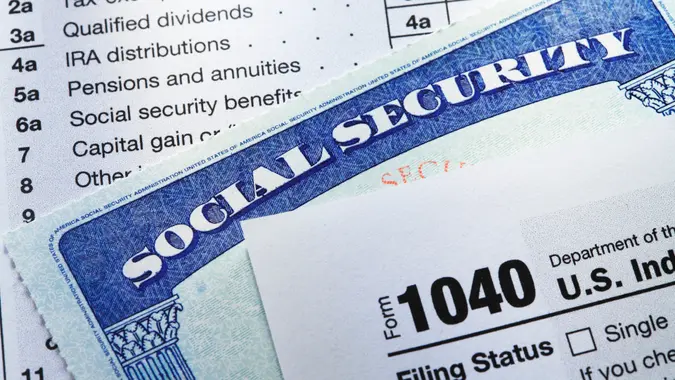Social Security Taxes: Pay Less With This Retirement Account

Commitment to Our Readers
GOBankingRates' editorial team is committed to bringing you unbiased reviews and information. We use data-driven methodologies to evaluate financial products and services - our reviews and ratings are not influenced by advertisers. You can read more about our editorial guidelines and our products and services review methodology.

20 Years
Helping You Live Richer

Reviewed
by Experts

Trusted by
Millions of Readers
When it comes to retirement planning, understanding the different investment vehicles and tax implications can make a significant difference in your financial well-being. One strategic approach involves utilizing a Roth IRA to potentially reduce the taxes you pay on Social Security benefits. Here’s how you can leverage a Roth IRA to achieve this goal.
Exploring Roth IRA Investments
Once you’ve maximized your employer’s 401(k) match, turning your attention to a Roth IRA is a wise next step. Roth IRAs, particularly those opened through a brokerage firm, offer several benefits, including potential impacts on your Social Security benefits. This aspect, while not widely known, can be a compelling reason to incorporate a Roth IRA into your retirement strategy.
Understanding Roth IRA Benefits
Unlike traditional 401(k)s and IRAs, contributions to a Roth IRA are made with after-tax dollars. This means they don’t reduce your taxable income in the contribution year. However, the real advantage of a Roth IRA lies in its tax-free withdrawals during retirement, provided specific conditions are met. This feature can be especially beneficial for managing your tax liabilities during your retirement years.
Impact on Social Security Benefits
Social Security benefits, which were not taxed until 1984, now face partial taxation if your income exceeds certain thresholds. This is where the Roth IRA plays a crucial role.
Distributions from a Roth IRA are not considered taxable income. Consequently, IRA distributions don’t contribute to the income levels that trigger taxation on Social Security benefits. This feature of Roth IRAs can effectively lower your taxable income in retirement, potentially reducing or eliminating taxes on your benefits.
For example, imagine you have $500,000 in a Roth IRA, and you plan to withdraw it evenly over 20 years of retirement ($25,000 per year). If these were taxable distributions from a traditional IRA, and you were in the 22% tax bracket, you would owe about $5,500 in taxes on those distributions each year ($25,000 times 22%).Over 20 years, this would total $110,000 in taxes. With a Roth IRA, you would owe $0 in taxes on these distributions, effectively saving you $110,000 in taxes over 20 years.
Roth IRA: A Strategic Choice for Avoiding Social Security Taxes
A significant number of households receiving Social Security benefits face taxation on these benefits. Investing in a Roth IRA can be a strategic move to mitigate the risk of these taxes. As income levels naturally increase over time, the thresholds for taxable benefits mean more retirees might find themselves paying taxes on Social Security benefits. A Roth IRA can serve as a buffer against this tax liability.
Prioritizing Contributions: 401(k) Match before Roth IRA
While a Roth IRA offers distinct advantages, it’s crucial to first exhaust the potential of your employer’s 401(k) match (if your employer offers one). This match is essentially free money, boosting your retirement fund without any additional effort on your part. Reach out to your human resources department to make sure you are taking full advantage of this benefit.
The immediate return on investment through employer matching should not be overlooked. You should only consider diverting additional funds into a Roth IRA after securing this free money. This approach ensures you’re maximizing the benefits of both retirement savings vehicles.
Bottom Line
A Roth IRA can be a powerful tool for retirement planning, particularly for managing Social Security tax liabilities. By first capitalizing on employer 401(k) matches and then strategically using a Roth IRA, you can create a more tax-efficient retirement income, providing greater financial stability and peace of mind during your golden years.
Editor's note: This article was produced via automated technology and then fine-tuned and verified for accuracy by a member of GOBankingRates' editorial team.
 Written by
Written by 
























